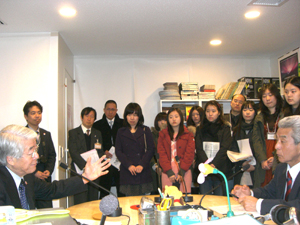I think it is important for communities to be strong enough to do things for themselves. I think ‘self-help’ and ‘mutual-help’ is very important.
Kobe City Mayor, Tatsuro Yada
Talk 1
I come to Takatori about 3 or 4 times a year and Noda Hokubu in the neighborhood is a model community for community development. Only a person who saw what it was like here just after the earthquake could know how much it has recovered. The Governor of West Australia who saw what it was like at the time said that he was amazed at the recovery made.At the time of the earthquake I was working in the Port and Urban Projects Bureau on the Kobe Airport project. We in the bureau worked hard on organizing aid supplies that had arrived through the port, and supplies from the north through Shin Kobe Tunnel and Rokko Tunnel, storing them in Shin Kobe Station and organizing their distribution. Many people had lost their lives so we wanted to do our best for those who survived.
As time progressed, victims moved from shelters to temporary housing then into public housing or built their own house. What became very important then was the care of the elderly and handicapped. We also had to consider the many foreign people living in Kobe. We divided the work into sections and I was responsible medical care, social welfare and health which received about a quarter of the city’s budget and one quarter of the city’s civil servants. I had to listen to many people and many organizations with my goal to secure the citizens’ welfare. We also worked to get the national government to introduce new systems, such as the long-term care insurance for the elderly.
We civil servants had to put our duty first which often meant not being able to return home or get sleep. After a year or so circumstances changed and went onto the next stage – recovery of citizens’ livelihood. This presented different hardships. For example, when victims lived in temporary housing, they supported each other, but when they moved into post-earthquake public housing many of them became isolated and it was very difficult to create a community.
About half of the elderly victims entered housing in HAT Kobe. Many of them had come from temporary housing in different areas and were strangers to each other. It took over a year to create a community. One city officer after another went to the area to consult with the people, but what was really needed was for the people themselves to do something. People in the area who had originally been involved in community work came forward and got involved and things started to improve over a period of 1 to 3 years. Special homes and centers for the elderly were set up and had counseling offices and this seemed to have a good effect.
I have been Mayor for 8 years. For successful community development, I think it is important for communities to be strong enough to do things for themselves. I think ‘self-help’ and ‘mutual-help’ is very important and will play a big role if a major disaster occurs. Using Bosai Fukushi Communities and community committees, etc. as a base, communities need to be able to do things for themselves. It is very important that community activities can be seen and are sustainable. Partnerships are also being formed between communities and local government and this is very reassuring.
Talk 2
Construction of earthquake resistant housing and making former houses earthquake resistant is not progressing as we would like. The rate is about 70% completed but about 20% still to be done. The city and prefecture work together to provide disaster resistance testing free of charge. Until recently, if a house was found to need reinforcement, city-prefecture grants of 600,000 to 900,000 were available. In fact, grants up to 2,500,000 can be receive. Grants are given according to the needs. The Prefecture-City Earthquake Fund is also being used to promote earthquake resistance reinforcement for private houses and condominiums. Reinforcement of schools is well advanced. People should remember that reinforcing their house protects their lives. People don’t have to rebuild their house, just have it reinforced.
(Could tell us about Kobe City’s stance on multicultural existence.)
About 44,000 foreign people from 134 countries live in Kobe. The largest group is Korean with 25,000, next Chinese with 12,000, followed by Vietnamese and Americans. The numbers of Brazilians and Indians have decreased. Chuo-ku has the largest number of foreigners with 12,000, Nagata-ku is next with 7,500 and many Vietnamese. Communication is very important for successful coexistence. It is very important for everything, from making application procedures to the simple task of shopping. Of course, it would be easier if the foreign person learns Japanese, but multi-language signs and notices and the use of interpreters is also important. The city supports private groups active in this area. In June, the former center for Japanese emigrants to Brazil which underwent reconstruction will open as an emigrants’ museum and intercultural exchange center.
Some foreign people who come to the city feel more could be done. For example when they arrive at stations or the airport, they would like to have maps and information in foreign languages so they could go about on their own. There are now signs in six languages including Japanese around Kobe. My own business card is in four languages.
Regarding universal use and mobility, a higher level of consciousness is important. To increase the level of consciousness, it will be necessary to get people to realize that things will become more convenient for everyone and provide greater potential to all kinds of people. Taking action and showing that it is important is one thing that has to be done. I think creating a society where we help and support each other is a starting point to make Kobe a more universal city.

